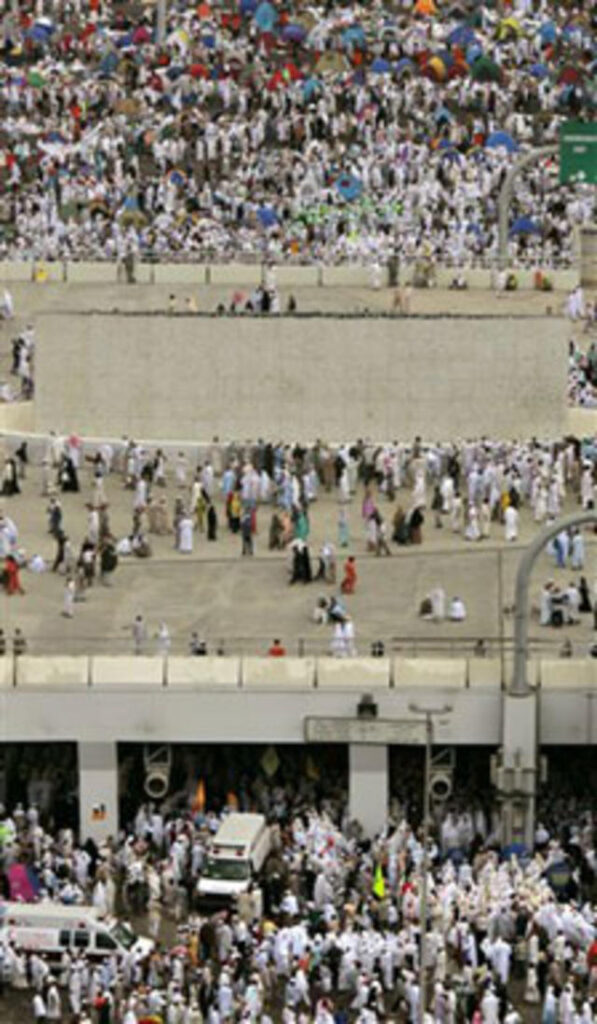
Jamaraat Bridge Saudi Arabia crowd incident 12/01/2006
Hundreds killed in hajj stampede
At least 345 people were killed and 1,000 injured in a stampede on the final day of a symbolic stoning ritual at the hajj pilgrimage to Mecca today.
Mecca disaster toll rises to 76 (initial coverage)
The number of dead after a building collapse in the Saudi holy city of Mecca has risen to 76, an interior ministry official has said.
At least 345 die in stampede at pilgrimage
Thousands of Muslim pilgrims rushing to complete a symbolic stoning ritual during the hajj tripped over baggage yesterday, causing a crush in which at least 345 people were killed and hundreds injured, despite Saudi attempts to prevent stampedes that have plagued the annual event.
Pilgrims recount horror of hajj stampede
At least 345 Muslim pilgrims were trampled to death on Thursday as they tripped over luggage in a scramble to hurl pebbles at symbols of Satan during the annual pilgrimage, Saudi officials said.
Hajj crush police 'not to blame'
Saudi officials have denied that police could have done more to stop a stampede during the Hajj pilgrimage, now known to have killed at least 362 Muslims.
Saudi Arabia: Facing Criticism, Saudis Blame Pilgrims For Hajj Stampede
Prague, 13 January 2006 (RFE/RL) — They filed one by one into the morgue, hundreds of pilgrims anxious to find out if their loved ones were among the victims.
Hajj Stampede
Thousands of Muslim pilgrims in Mina, Saudi Arabia, were rushing to complete a symbolic stoning ritual and tripped over baggage, causing a crush in which at least 345 people were killed and at least 1,000 were injured on Thursday, Jan. 12, 2006.
Hundreds killed in Hajj stampede
At least 345 Muslim pilgrims have died in a crush during the stone-throwing ritual at the Hajj pilgrimage in Saudi Arabia, officials say.
Stoning the Devil: Ritual Turned Tragedy
There was a tragedy in Saudi Arabia today. Hundreds of people were killed in a stampede as they were participating in one of the rituals of the hajj, the pilgrimage. Apparently, some people in the crowd brought their baggage with them; others tripped over it and stumbled. And in the crush, at least 345 people were killed and hundreds more injured. The Saudi government has tried to ease the crowding to prevent this kind of disaster. In past years, pilgrims have also been killed during the same ritual. As commentator Anisa Mehdi explains, it involves throwing stones at three pillars that represent the devil.
Hajj stampede kills 345
Hundreds of pilgrims have been crushed to death and hundreds more injured, during a stoning ritual on the last day of the Hajj, the Saudi health minister has said.
Hajj stampede raises negligence concerns
A stampede that has killed at least 345 people has sparked calls for better management of the annual hajj Muslim pilgrimage in Saudi Arabia.
Four Chinese pilgrims among 345 dead in Hajj stampede
Muslim pilgrims tripped over luggage while hurrying to ritually stone the devil Thursday, causing a crush that trampled at least 345 people to death in the latest stampede to mar Islam’s annual hajj.
Safety on the Jamarat Bridge
During the Hajj, Muslims travel to the city of Mecca in Saudi Arabia—for them, it’s a holy pilgrimage. Millions go every year; it happens between December and January during the 11th month of the Islamic (lunar-based) calendar, which means it moves around on the Julian Gregorian (solar-based) calendar.
The Hajj Stampede Is a Fluid Dynamics Problem
Mecca is the holiest city in Islam, the storied site of key locations from the Quran and, once a year, center of the hajj, a sacred pilgrimage that brings upwards of 3 million people to Saudi Arabia from all over the world. This week Mecca was also the site of a tragedy—nearly 800 people killed in a stampede in Mina, the semi-permanent tent city that houses tens of thousands of pilgrims. It wasn’t the first time something like this has happened during the hajj, and just as before, the causes remain the same: physics and evolutionary psychology.
Reviewing Safety at the Hajj
The Saudi king has ordered officials to “raise the level of organization” after a stampede killed more than 700 Muslim pilgrims.
Hundreds killed in hajj stampede, bodies, rescue
STORYLINE:
Thousands of Muslim pilgrims rushing to complete a symbolic stoning ritual during the hajj in Saudi Arabia tripped over luggage on Thursday, causing a crush in which at least 345 people were killed, the Interior Ministry said.
Improving Pilgrim Safety During the Hajj: An Analytical and Operational Research Approach
The Hajj, the annual Muslim pilgrimage to Makkah in Saudi Arabia, is one of the largest pedestrian events in the
world. Each year, up to four million pilgrims approach the holy sites in the region of Makkah to perform their
religious duty. The key ritual, the stoning-of-the-devil, is particularly crowded. Until 2006, several crowd-related
disasters led to thousands of casualties. In the aftermath of such a disaster in early 2006, the Ministry of
Municipal and Rural Affairs of the Kingdom of Saudi Arabia (MOMRA) launched many projects to prevent future
crowd-related accidents. In particular, MOMRA began the development of an operations research (OR)-based
decision support system (ORDSS) for crowd management. ORDSS employs a range of tools from OR, analytics,
and crowd dynamics. At its core, it implements a scheduling tool and a real-time video tracking system. The
video tracking system measures infrastructure utilization, and an integrated series of mixed-integer programs
and quadratic programs balance capacity utilization by considering preferred stoning times and infrastructure
capacities. The ORDSS provides MOMRA with solutions that enable uncongested and smooth pilgrim flows and
extensive real-time reporting. From 2007 to 2014, OR helped stop the tragic loss of human life that resulted from
these crowd-related accidents. Unfortunately, a crowd-related disaster, which resulted in hundreds of casualties,
occurred during Hajj season 2015; however, for this Hajj season, the authors and MOMRA were no longer in
charge of the scheduling and routing recommendations for the stoning-of-the-devil ritual during the Hajj.
Numerical Simulation of the Flow of Crowds at the Jamarat Bridge during the Annual Hajj Event
The huge number of pilgrims to the holy Mecca in the Hajj needs high awareness of crowd safety management. The stoning of the Jamarat, which is one of the rituals of the Hajj, undergoes the most dangerous crowd movements where fatal accidents occurred. This work investigates some problems related with the crowd dynamics when stoning the Jamarat pillars and gives some solutions. The main idea of this research is to suppose that the crowd dynamics is assimilated to fluid movement under certain conditions. Numerical simulation using a computational fluid dynamics program is used to solve Navier-Stokes equations governing the mechanics of homogeneous and incompressible fluid in a domain similar to the Jamarat Bridge from the entrance to the middle Jamarah. Some solutions are proposed inspired by the flow solutions to better manage crowd movements in the Jamarat Bridge and eventually in other similar dynamics events like sporting events.
A Pilgrim Scheduling Approach to Increase Safety During the Hajj
Abstract.
The Hajj—the great pilgrimage to Mecca,Saudi Arabia—is oneof the fivepillars
of Islam. Up to four million pilgrims perform the Hajj rituals every year. This makes it
one of the largest pedestrian problems in the world. Ramy al-Jamarat—the symbolic
stoning of the devil—is known to be a particularly crowded ritual. Up until 2006, it was
repeatedly overshadowed by severe crowd disasters. To avoid such disasters, Saudi au
thorities initiated a comprehensive crowd management program. A novel contribution to
these efforts wasthedevelopmentofanoptimizedscheduleforthepilgrimsperformingthe
stoning ritual. A pilgrim schedule prescribes specific routes and time slots for all registered
pilgrim groups. Together, the assigned routes strictly enforce one-way flows toward and
from the ritual site. In this paper, we introduce a model and a solution approach to the
Pilgrim Scheduling Problem. Our multistage procedure first spatially smooths the utili
zation of infrastructure capacity to avoid dangerouspedestrian densities in the network.
In the next optimization step, it minimizes overall dissatisfaction with the scheduled
time slots. We solve the Pilgrim Scheduling Problem by a fix-and-optimize heuristic, and
subsequently simulate the results to identify necessary modifications of the scheduling
constraints. Our numerical study shows that the approach solves instances with more
than 2.3 million variables in less than 10 minutes on average. At the same time, the gap
between optimal solution and upper bound never exceeds 0.28%. The scheduling ap
proach wasanintegralpartof theHajj planningprocess in 2007–2014and2016–2017. No
crowd disaster occurred in these years. Our approach was not applied in 2015, when
a severe crowdcrushhappenedclose to the ritual site. We briefly discuss possible causes
and consequences of this accident.
Hajj crush police 'not to blame'
Saudi officials have denied that police could have done more to stop a stampede during the Hajj pilgrimage, now known to have killed at least 362 Muslims.





